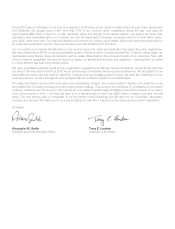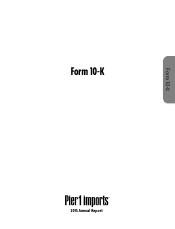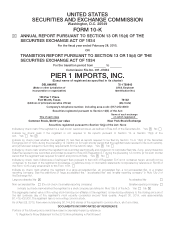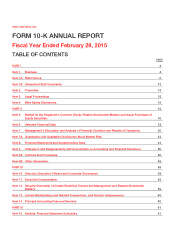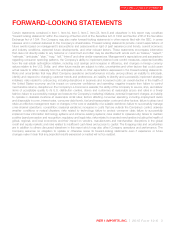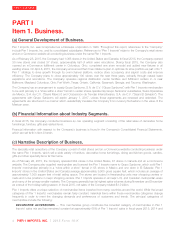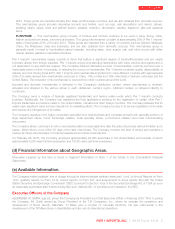Pier 1 2015 Annual Report Download - page 14
Download and view the complete annual report
Please find page 14 of the 2015 Pier 1 annual report below. You can navigate through the pages in the report by either clicking on the pages listed below, or by using the keyword search tool below to find specific information within the annual report.
ITEM 1A. RISK FACTORS.
resale of the returned merchandise. Introductions of new merchandise, changes in merchandise mix, associate selling behavior,
merchandise quality issues, changes to the Company’s return policy, e-Commerce return behavior, changes in consumer
confidence, new delivery channels/methods or other competitive and general economic conditions may cause actual returns to
exceed the provision for estimated merchandise returns. An increase in merchandise returns that exceeds the Company’s
current provisions could negatively impact the business and financial results.
A disruption in the operation of the domestic portion of the Company’s supply chain, or the
e-Commerce website, could impact the Company’s ability to deliver merchandise to its
stores and customers, which could impact its sales and results of operations.
The Company maintains regional distribution centers in Maryland, Ohio, Texas, California, Georgia and Washington. At these
distribution centers, merchandise is received, allocated, and shipped to the Company’s stores and customers, and at the
Company’s fulfillment centers in Ohio and Texas, e-Commerce orders are fulfilled. Major catastrophic events such as natural
disasters, fire or flooding, malfunction or disruption of the information systems, a disruption in communication services or power
outages, or shipping interruptions (including labor issues at the ports) could delay distribution of merchandise to the Company’s
stores and customers. Such disruptions could have a negative impact on the Company’s sales and results of operations.
Failure to successfully manage and execute the Company’s marketing initiatives could have
a negative impact on the Company’s business and results of operations.
The success and growth of the Company depends on generating customer traffic in order to produce sales in its stores and
through the Company’s e-Commerce website. Successful marketing efforts require the ability to obtain customer information and
to reach customers through their desired mode of communication utilizing various media outlets. Media placement decisions are
generally made months in advance of the scheduled release date. While gathering information about customers, the Company
must consider the customers’ desire for privacy and the need to comply with applicable laws and regulations. Any future
changes in privacy laws or their interpretation or enforcement by courts and governmental agencies could adversely impact our
ability to market to customers. The Company’s inability to obtain and use customer information, accurately predict and respect its
customers’ preferences, utilize the desired modes of communication, or ensure availability of advertised products may negatively
impact the business and operating results.
Changes to estimates related to the Company’s property and equipment, or financial results
that are lower than its current estimates at certain store locations and determinations to
close under-performing stores, may cause the Company to incur impairment charges on
certain long-lived assets, negatively affecting its financial results.
The Company makes certain accounting estimates and projections with regards to individual store operations as well as overall
Company performance in connection with its impairment analyses for long-lived assets in accordance with applicable accounting
guidance. An impairment charge is required when the carrying value of an asset exceeds the expected undiscounted future cash
flows of the asset. The projection of future cash flows used in this analysis requires the use of judgment and a number of
estimates and projections of future operating results. If actual results differ from the Company’s estimates, additional charges for
asset impairments may be required in the future. If impairment charges are significant, the Company’s financial results could be
negatively affected.
Risks Related to Profitability
The Company’s success depends, in part, on its ability to operate in desirable locations at
reasonable rental rates and to close underperforming stores at or before the conclusion of
their lease terms.
The profitability of the business depends on operating the current store base at a reasonable profit, opening and operating new
stores at a reasonable profit, and identifying and closing underperforming stores. For a majority of the Company’s current store
base, a large portion of a store’s operating expense is the cost associated with leasing the location. Management actively
monitors individual store performance and attempts to negotiate favorable lease expenses to ensure stores can remain profitable
or have the ability to rebound to a profitable state. Current locations may not continue to be desirable as the Company’s omni-
channel strategy evolves or demographics change, and the Company may choose to close underperforming stores before lease
expiration and incur lease termination costs associated with those closings. On April 8, 2015, the Company announced that it
had initiated a plan to optimize its store portfolio as part of its ‘1 Pier 1’ strategy to drive growth through its omni-channel platform,
reduce occupancy and payroll costs and improve efficiency. The Company’s inability to achieve the desired cost reduction and
8PIER 1 IMPORTS, INC. 2015 Form 10-K


